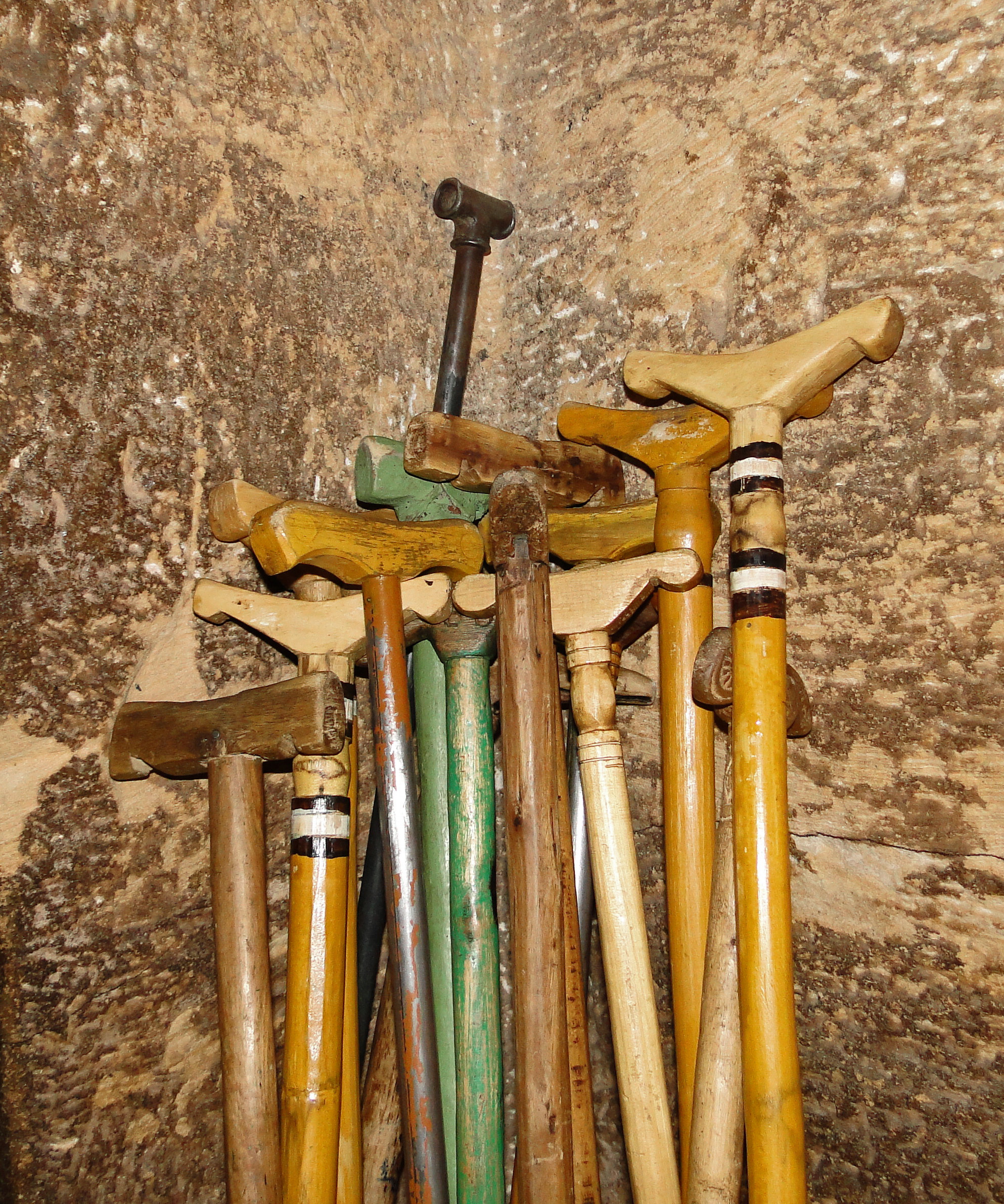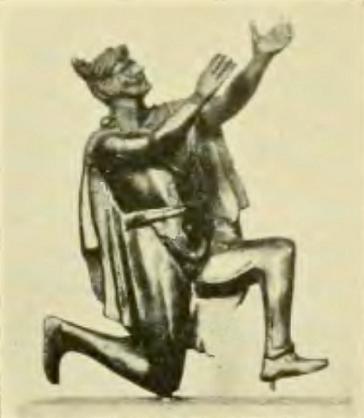|
Prayer Stick
A prayer stick is a stick-shaped object used for prayer. Background In the rituals of the Puebloan people of the American Southwest contain many prayers; thus the Zuñi have prayers for food, health, and rain. Prayer-sticks, that is sticks with feathers attached as supplicatory offerings to the "spirits," were largely used by the Pueblo. These sticks are usually made of cottonwood about seven inches long, and vary in shape, color, and the feather attached, according to the nature of the petitions, and the person praying. The stick is intended to represent the "god" to whom the feathers convey the prayers that are breathed into the "spirit" of the plumes. The Hopi Indians had a special prayer-stick to which a small bag of sacred meal was attached. Green and blue prayer-sticks are often found in the Pueblo graves and especially in the ceremonial graves of Arizona. Other cultures In Ethiopian culture, the handle of a , a prayer stick, is shaped like a tau cross. The mequamia are ... [...More Info...] [...Related Items...] OR: [Wikipedia] [Google] [Baidu] |
Prayer Sticks - Ethiopia
File:Prayers-collage.png, 300px, alt=Collage of various religionists praying – Clickable Image, Collage of various religionists praying ''(Clickable image – use cursor to identify.)'' rect 0 0 1000 1000 Shinto festivalgoer praying in front of the Tagata fertility shrine rect 1000 0 2000 1000 Balinese Hindu bride praying during a traditional wedding ceremony rect 2000 0 3000 1000 Muslim pilgrim praying at the Masjid al-Haram rect 0 1000 1000 2000 Catholic Trappist monk praying before a crucifix rect 1000 1000 2000 2000 Ethiopian priest praying in Lalibela rect 2000 1000 3000 2000 Buddhists praying in Leh rect 0 2000 1000 3000 Sikh praying in Front of the Golden Temple in Amritsar rect 1000 2000 2000 3000 Members of the Mengjia Longshan Temple Association gather for a traditional Chinese prayer service rect 2000 2000 3000 3000 Jewish people praying at the Western Wall Prayer is an invocation or act that seeks to activate a rapport with an object of worship through del ... [...More Info...] [...Related Items...] OR: [Wikipedia] [Google] [Baidu] |
Puebloans
The Pueblo peoples are Native Americans in the United States, Native Americans in the Southwestern United States who share common agricultural, material, and religious practices. Among the currently inhabited Pueblos, Taos Pueblo, Taos, San Ildefonso Pueblo, San Ildefonso, Acoma Pueblo, Acoma, Zuni Pueblo, New Mexico, Zuni, and Hopi are some of the most commonly known. Pueblo people speak languages from four different Language family, language families, and each Pueblo is further divided culturally by kinship systems and agricultural practices, although all cultivate varieties of corn (maize). Pueblo peoples History of the Pueblo peoples, have lived in the American Southwest for millennia and descend from the Ancestral Puebloans, Ancestral Pueblo peoples. The term ''Anasazi'' is sometimes used to refer to Ancestral Puebloans, but it is considered derogatory and offensive. "Anasazi" is a Navajo language, Navajo adoption of a Ute Indian, Ute term that translates to ''Ancient Enem ... [...More Info...] [...Related Items...] OR: [Wikipedia] [Google] [Baidu] |
Southwestern United States
The Southwestern United States, also known as the American Southwest or simply the Southwest, is a geographic and cultural list of regions of the United States, region of the United States that includes Arizona and New Mexico, along with adjacent portions of California, Colorado, Nevada, Oklahoma, Texas, and Utah. The largest cities by List of metropolitan statistical areas, metropolitan area are Phoenix, Arizona, Phoenix, Las Vegas, El Paso, Texas, El Paso, Albuquerque, and Tucson, Arizona, Tucson. Before 1848, in the historical region of Santa Fe de Nuevo México as well as parts of Alta California and Coahuila y Tejas, settlement was almost non-existent outside of New Mexico's pueblos and Santa Fe de Nuevo México#Regions and municipalities, Spanish or Mexican municipalities. Much of the area had been a part of New Spain and Mexico until the United States acquired the area through the Treaty of Guadalupe Hidalgo in 1848 and the smaller Gadsden Purchase in 1854. While the regio ... [...More Info...] [...Related Items...] OR: [Wikipedia] [Google] [Baidu] |
Zuni People
The Zuni (; formerly spelled ''Zuñi'') are Native American Pueblo peoples native to the Zuni River valley. The Zuni people today are federally recognized as the Zuni Tribe of the Zuni Reservation, New Mexico, and most live in the Pueblo of Zuni on the Zuni River, a tributary of the Little Colorado River, in western New Mexico, United States. The Pueblo of Zuni is south of Gallup, New Mexico. The Zuni tribe lived in multi level adobe houses. In addition to the reservation, the tribe owns trust lands in Catron County, New Mexico, and Apache County, Arizona. The Zuni call their homeland ''Halona Idiwan’a ''or Middle Place. The word ''Zuni'' is believed to derive from the Western Keres language ( Acoma) word ''sɨ̂‧ni'', or a cognate thereof. History Archaeology suggests that the Zuni have been farmers in the general area for 3,000 to 4,000 years. It is now thought that the Ancestral Zuni people inhabited the Zuni River valley from the last millennium B.C., when the ... [...More Info...] [...Related Items...] OR: [Wikipedia] [Google] [Baidu] |
Hopi
The Hopi are Native Americans who primarily live in northeastern Arizona. The majority are enrolled in the Hopi Tribe of Arizona and live on the Hopi Reservation in northeastern Arizona; however, some Hopi people are enrolled in the Colorado River Indian Tribes of the Colorado River Indian Reservation at the border of Arizona and California. The 2010 U.S. census states that about 19,338 US citizens self-identify as being Hopi. The Hopi language belongs to the Uto-Aztecan language family. The primary meaning of the word ''Hopi'' is "behaving one, one who is mannered, civilized, peaceable, polite, who adheres to the Hopi Way." Some sources contrast this to other warring tribes that subsist on plunder.Connelly, John C., "Hopi Social Organization." In Alfonso Ortiz, vol. ed., ''Southwest'', vol. 9, in William C. Sturtevant, ed., ''Handbook of North American Indians'', Washington, D.C.: Smithsonian Institution, 1979: 539–53, p. 551 ''Hopi'' is a concept deeply rooted in the c ... [...More Info...] [...Related Items...] OR: [Wikipedia] [Google] [Baidu] |
Ethiopian Ecclesiastical Titles
Ethiopian ecclesiastical titles refers to the offices of the Ethiopian Orthodox Tewahedo Church, a hierarchical organization. Some of the more important offices are unique to it. Titles Ethiopian ecclesiastical titles include: *Patriarch we Re'ese Liqane Papasat — Patriarch and First of the Archbishop, meaning Catholicos. Since 1959, the title of the head of the Ethiopian Orthodox Church is Patriarch Catholicos of Ethiopia. The first Patriarch, Abuna Basilios was enthroned by the Coptic Orthodox Pope Cyril VI in 1959, and so the Patriarchs of Ethiopia are part of the Apostolic succession of the Holy See of St. Mark. The Ethiopian Patriarchate combined the old offices of Abuna and Ichege (see below). In 2001, the title of Archbishop of Axum was added to the titles of the Patriarch after Axum was elevated to the rank of an Archdiocese by the Holy Synod. * Abuna — Metropolitan Archbishop of the Ethiopian Orthodox Church. From the 4th century until the middle of the 20th cen ... [...More Info...] [...Related Items...] OR: [Wikipedia] [Google] [Baidu] |
Ikupasuy
Ikupasuy are wooden, carved ceremonial sticks used by Ainu men when making offerings to spirits. Background The central section of an ikupasuy is decorated, featuring animals, floral motives as well as abstract designs. The ends of an ikupasuy bear designs that represent the patriarchal lineage of the owner. The Ainu believe that the designs on the ends of the ikupasuy help the spirits in identifying the person who made the offering. The underside of the ikupasuy may on some occasions be carved with various symbols called shiroshi. A common shiroshi is symbol representing the killer whale. The pointed end of the ikupasuy is known as the 'tongue'. The libation process is performed when the ikupasuy's ‘tongue' placed into a lacquerware cup or saucer, containing millet beer or sake. Drops of the liquid then fall upon the venerated object. The Ainu limited their representation of animals to the ikupasuy. Ainu men occasionally used the ikupasuy as a mean to lift their moustaches, l ... [...More Info...] [...Related Items...] OR: [Wikipedia] [Google] [Baidu] |
Walking Stick
A walking stick (also known as a walking cane, cane, walking staff, or staff) is a device used primarily to aid walking, provide postural stability or support, or assist in maintaining a good posture. Some designs also serve as a fashion accessory, or are used for self-defense. Walking sticks come in many shapes and sizes and some have become collector's items. People with disabilities may use some kinds of walking sticks as a crutch, but a walking cane is not designed for full weight support but used to help with balance. The walking stick has also historically been known to be used as a self-defense weapon, and may conceal a sword or knife. Hikers use walking sticks, also known as trekking poles, pilgrim's staffs, hiking poles, or hiking sticks, for a wide variety of purposes: as a support when going uphill or as a brake when going downhill; as a balance point when crossing streams, swamps, or other rough terrain; to feel for obstacles in the path; to test mud and wate ... [...More Info...] [...Related Items...] OR: [Wikipedia] [Google] [Baidu] |
Native American Relics
Native may refer to: People * '' Jus sanguinis'', nationality by blood * '' Jus soli'', nationality by location of birth * Indigenous peoples, peoples with a set of specific rights based on their historical ties to a particular territory ** Native Americans (other) In arts and entertainment * Native (band), a French R&B band * Native (comics), a character in the X-Men comics universe * ''Native'' (album), a 2013 album by OneRepublic * ''Native'' (2016 film), a British science fiction film * ''The Native'', a Nigerian music magazine In science * Native (computing), software or data formats supported by a certain system * Native language, the language(s) a person has learned from birth * Native metal, any metal that is found in its metallic form, either pure or as an alloy, in nature * Native species, a species whose presence in a region is the result of only natural processes * List of Australian plants termed "native", whose common name is of the form "native . . ." ... [...More Info...] [...Related Items...] OR: [Wikipedia] [Google] [Baidu] |




